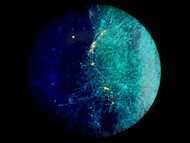The Role of Microscopy in Environmental Science: Studying Microplastics
Apr 3rd 2025
 Microplastics are everywhere—in our oceans, rivers, soil, air, and even the food we eat. These tiny plastic particles, less than 5 millimeters in size, have become one of the most pressing environmental concerns of our time. As scientists work to better understand the impact of microplastics on ecosystems and human health, one essential tool continues to lead the way: the microscope.
Microplastics are everywhere—in our oceans, rivers, soil, air, and even the food we eat. These tiny plastic particles, less than 5 millimeters in size, have become one of the most pressing environmental concerns of our time. As scientists work to better understand the impact of microplastics on ecosystems and human health, one essential tool continues to lead the way: the microscope.
What Are Microplastics and Why Are They a Concern?
Microplastics come from a variety of sources. Some are manufactured intentionally, such as microbeads used in cosmetics and cleaning products. Others are formed when larger plastic debris breaks down due to sunlight, weather, or physical abrasion. These particles are incredibly durable, making them persistent pollutants in natural environments.
The concern with microplastics goes beyond just their presence. They can absorb toxic chemicals, be ingested by wildlife, and travel up the food chain—potentially affecting human health. Understanding where microplastics are found, how they move, and what they’re made of is crucial for developing effective environmental policies and clean-up strategies.
How Microscopy Helps Scientists Study Microplastics
Microscopes are an indispensable tool in microplastic research. Since many microplastic particles are too small to be seen with the naked eye, researchers use microscopes to:
- Identify the size, shape, and structure of microplastics
- Differentiate between synthetic and organic particles
- Determine the polymer composition when paired with spectroscopy
- Quantify microplastics in water, soil, and biological samples
By magnifying these tiny particles, scientists can gain detailed insights that would otherwise be impossible to observe.
Types of Microscopes Used in Microplastic Analysis
1. Stereo Microscopes
Stereo microscopes are often used for the initial sorting and identification of microplastics. With lower magnification but a wide field of view, they help researchers spot microplastic particles in sediment or water samples and manually separate them for further analysis.
2. Compound Microscopes
Once particles are isolated, compound microscopes offer the higher magnification needed to closely examine surface features and morphology. This helps researchers distinguish microplastics from natural debris like sand grains or plant material.
3. Polarized Light Microscopy
Polarized light microscopes allow scientists to differentiate plastic types based on their optical properties. When viewed under polarized light, different polymers display unique colors and patterns, making this technique highly valuable for identifying the type of plastic present.
4. Digital Microscopes
Digital microscopes are becoming increasingly popular due to their ability to capture high-resolution images and video. These microscopes allow for easy documentation, image sharing, and even measurement of microplastics directly on-screen. They’re ideal for labs that require efficient analysis and reporting.
Sample Collection and Preparation for Microscopic Analysis
Before microplastics can be analyzed under a microscope, they need to be carefully collected and prepared. Researchers often gather samples from water bodies, soil, or biological tissues, then filter or digest the samples to isolate microplastics.
Steps typically include:
- Filtration: Passing samples through fine mesh or filters to catch particles
- Chemical digestion: Using enzymes or hydrogen peroxide to break down organic matter
- Density separation: Using saline solutions to separate plastics from heavier materials
Once isolated, the particles are mounted on microscope slides or petri dishes for imaging and identification.
Applications in Environmental Monitoring
Microscopic analysis of microplastics supports a wide range of environmental science initiatives. For example:
- Ocean health studies: Tracking microplastic levels in marine environments to understand their impact on aquatic life
- Drinking water safety: Detecting microplastics in tap and bottled water
- Agricultural impact: Studying how plastic pollution affects soil health and food crops
- Public policy: Providing data that informs regulations around plastic use and waste management
In all of these cases, microscopy delivers the visual evidence needed to support research findings and drive change.
How Microscope World Supports Microplastic Research
At Microscope World, we offer a variety of microscopes well-suited for environmental science applications. Whether you’re just beginning your research or are working in a professional lab setting, we can help you find the right equipment to detect, measure, and document microplastics effectively.
Our digital microscopes, in particular, are ideal for microplastic analysis. They allow researchers to:
- Capture high-resolution images of particles
- Perform precise measurements
- Easily archive and share data
- Enhance collaboration across research teams
We also offer customizable microscope kits, camera systems, and accessories to match your specific sample types and workflows.





